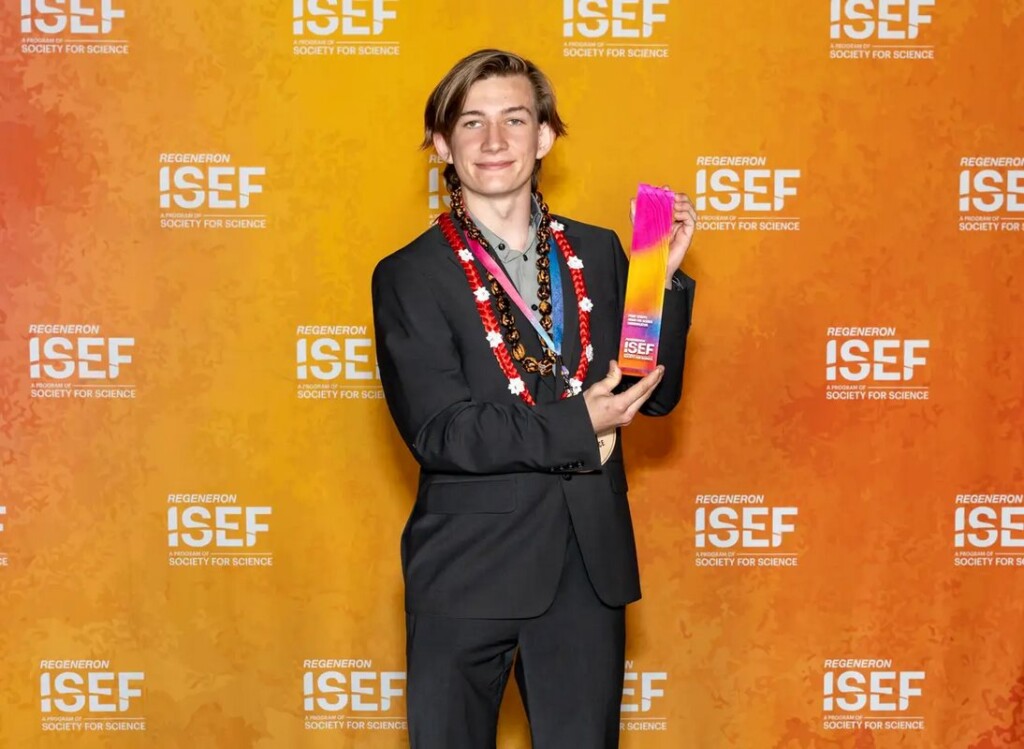
A young man has won a five-figure financial prize at the nation’s top science fair for his research into a mysterious outbreak of tumors he witnessed among the sea turtles under the waves of his home in Hawaii.
Maddux Springer lives on Oahu and spent most of his free time during the pandemic free diving among the reefs in Kāneʻohe Bay. Down among the quiet and peaceful corals, he couldn’t stop noticing that practically every green sea turtle he saw was covered in cauliflower-like tumors.
Whether young or old, the whole population seemed to be infected and slowly dying, prompting Springer to start what would become a 2.5-year research program. It might have gone faster if wildlife authorities had agreed to allow him to perform a biopsy on one of the tumors, and without this direct evidence, he had to find other ways to collect data.
His starting point took just a few minutes, as a Google search turned up that tumors on green sea turtles are likely a symptom of fibropapilomatosis, or FB for short, caused by a herpes-type virus that affects 97% of all sea turtles.
Springer felt the outlook was bleak, and began researching what was the cause and what, if anything, could be the cure. Last week, two-and-a-half years after he began his work, he was awarded the $10,000 Peggy Scripps Award for Science Communication, which he presented at the Regeneron International Science and Engineering Fair, the most prestigious in the country.
“It was an incredible feeling, just having my research validated,” Springer told Business Insider. “It’s been a very long time since I have felt like some change can be made from my research.”
MORE BRILLIANT YOUNG MINDS: Teen Boy Translating Ancient Texts Turned a 4,000-Year-old Scribe From Egypt into Advice for Modern Age
Because he couldn’t perform a biopsy, he was forced to collect data via photographs—which mostly told him what he already knew: nearly every green sea turtle in Kāneʻohe Bay had FB. However, the photos also clued him in on a possible cause. Sea turtles are key to maintaining the health of coral reefs worldwide as they eat algae that could otherwise suffocate the corals.
They’re not picky eaters, and will eat any species of algae they come across. FB requires an external trigger for the tumors to form, and previous research has shown that tumors have contained high amounts of the amino acid arginine. But how and why would the turtles be ingesting so much arginine?
The photographs taken by the underwater equivalent of trail cameras set by Springer in the bay showed that the turtles spent most of their days eating one algae species—an invasive one.
MORE NEWS LIKE THIS: High School Student Invents an A.I. Powered Trap That Zaps Invasive Lanternflies
Establishing probable cause, Springer’s breakthrough came when he found that the species they were eating absorbs 11 times more arginine than native species. He connected this to the fact that coastal pollution from cesspools, or uncontained septic pits dug underneath Hawaiian homes, are a large problem for sea life on the archipelago.
But correlation doesn’t equal causation, and so over 400 hours of free diving, Springer gathered hundreds of samples of the algae from across a wide area of the bay, dried it out, crushed it into powder, and sent it to a lab for analysis under a mass-spectrometer, a device which identifies the elemental composition of objects by looking at the light spectrum reflected off them.
Sure enough, the algae was rich in nitrogen, a key marker of raw sewage.
After 400 hours of diving and over 2 years of research, Springer believes that cesspools leaching wastewater through the porous Hawaiian soil into the bay are the cause of the tumors. The wastewater comes with significant amounts of arginine which is taken up by the algae that’s then eaten by the turtles.
WIZ KIDS THE WORLD OVER: Indian Teen Invents Gadget to Transform Dementia Care – Out of Concern for His Grandmother
“If we continue to go at this rate, and if we continue to just release raw wastewater into the bay, the environmental devastation is going to be unparalleled,” he said.
The grand prize winner of the Regeneron fair was Grace Sun, who took home $75,000 for a huge breakthrough in biomedical implant technology, GNN reported.
SHARE This Young Man’s Impressive Research Project And Just Rewards…




















